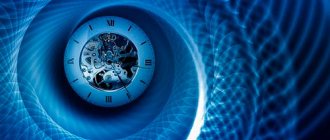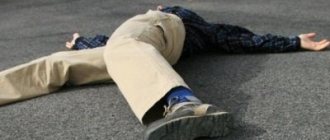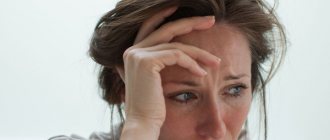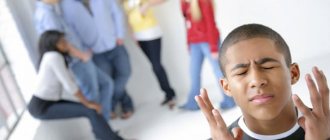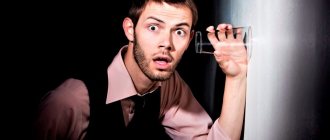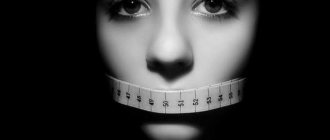Causes of neck muscle spasms
Provoking factors for the occurrence of spasms are:
- Hypothermia of the neck area. Most often, symptoms of neck muscle spasms appear in early spring, when, at the first warming, people try to take off winter clothes. It is important to remember that this period is very deceptive. A couple of trips outside with your neck uncovered will ensure a high probability of spasms.
- Staying in one position for a long time, sudden movements. In people leading a sedentary lifestyle, the cervical vertebrae take on additional stress. Stagnation of blood in this area inevitably leads to compression of blood vessels and spasms and pain in the neck. Sudden movements also lead to poor circulation and muscle spasms.
- Sodium deficiency in the body. Sodium is needed to keep muscle tissue in a relaxed state. With its deficiency, the muscles begin to contract involuntarily.
- Prolonged physical activity, including static exercise.
- Existing diseases: cervical radiculitis, cervical osteochondrosis, myositis, spinal injuries, neoplasms, hypertension, dysfunction of the thyroid gland, cardiovascular system, intervertebral hernia.
If neck muscle spasms are regular, you should consult a doctor to avoid negative consequences for the body.
Other reasons
However, this symptom is also inherent in other pathologies. So, there is an essential tremor - twitching of the head, which is associated with heredity. It can be observed even in a child, but more often appears in old age.
Often twitching of certain parts of the face can be observed in infants. And this, of course, is not associated with osteochondrosis. Where can such kids have it?! At this age, local tremor is the child’s body’s reaction to excitement.
You have noticed that a disturbance in the normal condition of the chin or cheeks occurs when crying a lot. This is how the body reacts to stimulation. As you can see, only in an adult can pathology be the result of the development of cervical osteochondrosis.
By the way, experts say that the disease develops over many months and is preceded by conditions that make it easy to determine that the patient suffers from disorders in the spinal system. And I say all this because osteochondrosis must be treated as soon as its first signs are detected.
Symptoms of muscle spasms in the neck
Symptoms of neck muscle spasms are pronounced: severe pain and limitation or inability to turn the head.
It is important to determine the exact location of the pain syndrome and its degree - this will help identify the causes of spasms.
For example, the appearance of discomfort in the neck, turning into pain in the back of the head, shoulders and temples, signals the presence of osteochondrosis. Spasm of the muscles of the neck and shoulders gradually intensifies and leads to severe limitation of motor activity.
Headaches of various types with a feeling of pressure on the eyeballs, severe weakness and dizziness indicate problems with the vessels of the neck.
If neck muscle spasms occur frequently, treatment should be started immediately. Stagnation of blood in the vessels leads to disruption of the normal functioning of the brain.
Tinnitus, deterioration of vision and memory, insomnia are only a small part of the consequences. Lack of attention to the problem can cause a stroke. At best, the person will remain disabled, at worst, death.
Diagnosis of the patient's condition
Treatment begins after accurately identifying the causes causing the symptoms of neck muscle spasms.
Diagnostic measures include:
- Examination by a neurologist to detect the exact localization of pain and areas of muscle tension.
- X-ray examination to exclude the presence of spinal injuries, neoplasms, inflammation of the skeletal system, etc.
- If it is difficult to make a diagnosis, magnetic resonance imaging and computed tomography may be required. They can detect neoplasms in soft tissues and intervertebral hernia.
If the identified disease is not infectious in nature, then standard tests (blood, urine) are usually not performed.
Diagnosis of cranialgia
To prevent a part of the head from shooting through acute pain, it is necessary to accurately determine the reasons for its occurrence. To do this, you often have to undergo an extensive examination.
After being examined by a therapist and passing the necessary tests, the patient is referred to specialists:
- The ENT doctor will check the hearing organs and examine the nasal cavity to rule out infectious diseases;
- a vertebrologist will check the condition of the spine to exclude cervical osteochondrosis;
- A neurologist performs brain diagnostics to exclude dangerous pathologies and inflammatory processes.
If one of these diseases is detected, a thorough examination of the head and cervical spine is prescribed: MRI, X-ray, ultrasound.
The first stage of treatment for muscle spasms in the neck
The primary actions are aimed at eliminating or reducing pain and relieving muscle tension.
To relax muscles, the drug most often prescribed is Baclofen. Instructions for use (price listed below) position it as an effective drug for this disease. Taking Baclofen involves increasing the dosage every 3 days until a therapeutic effect is achieved; its price varies depending on the dosage - from 200 to 500 rubles.
In order to anesthetize the affected area, drugs belonging to the pharmacological group of non-steroidal anti-inflammatory drugs are prescribed. This is mainly Ibuprofen or medications based on it. Ibuprofen instructions for use (price 50-150 rubles) recommend taking it as prescribed by a doctor. The tablets are taken 3 times a day for no more than 5 days. It is also available in the form of an ointment; in case of neck muscle spasm, it reduces pain in a short time.
“Baclofen” instructions for use (the price of the drug is indicated above) also do not recommend prescribing it to yourself. Any medication must be prescribed by a specialist. No matter how well, for example, Ibuprofen has proven itself, the instructions for use (the price of the medicine is quite low) cannot replace a full-fledged consultation and recommendations of a doctor. If there are contraindications, the above drugs are replaced with others with a similar effect. Self-medication is unacceptable!
Methods for treating lumbago in the head
Pills
Acute diseases accompanied by severe pain must be treated in a hospital. If the cause of cranialgia is a bacterial infection, then the following drugs are effective:
- Antibiotics: Ampiox, Ceftriaxone, Zitrox. They can be prescribed in the form of tablets or injections.
- Anti-inflammatory medications: Indomethacin, Ibuprofen, Diclofenac.
- Combined medicines with analgesic effects: Spasgo, Spasmalgon.
- Vitamin B complex in the form of injections.
If lumbago in the head is caused by neuritis and muscle tension, then the following remedies are effective:
- Nootropic and neuroprotective medications in the form of injections and tablets: Actovegin, Thiocetam, Cortexin, Piracetam.
- Tranquilizers: Tozepam, Phenazepam.
To treat osteochondrosis, ointments containing non-steroidal components are included in the therapy:
- Fastum Gel;
- Diklak;
- Finalgon.
Exercise therapy
Simple physical exercises for the spine are indicated for eliminating the causes of the development of lumbago in the head and their prevention. All procedures are aimed at strengthening the muscle corset, improving posture, and normalizing blood flow in the cervical spine. A set of exercises is prescribed by a doctor, but in practice the following are most often used:
- Take a horizontal position, legs straight, arms along the body. Raise your head and remain in this position for 3-7 seconds. Repeat exercises 1-3 times.
- Place your hands on your shoulders and perform circular movements in one direction and then in the other direction 4 times. Repeat the exercises 2-3 times.
- Place your arms along your body, clasp your legs at the knees, and begin walking in a lying position. Perform for 30 seconds, do 2-4 repetitions.
- Place your arms along your body, then inhale and move them upward through your sides, while exhaling, pull your knees to your chest without lifting your head. Repeat exercises 4-6 times.
Massage
With the help of massage, you can work on soft tissues in superficial pathological processes. Thanks to the targeted effect on biologically active areas, it is possible to quickly relieve pain. To get maximum results, you need to use your fingertips to massage the brow ridges, the line between the eyebrows from the bridge of the nose to the place of hair growth, as well as the temples. Stroking the top of the head will help to consolidate the massage if you move towards the neck. Essential oils will help enhance the effect of the procedure:
- sandalwood;
- lavender;
- rosewood.
Physiotherapy
Physiotherapy is effective for shooting pain in the head. In inpatient settings, the following procedures are prescribed:
- electrophoresis;
- UHF;
- galvanic current;
- magnetotherapy.
At home, with the permission of a doctor, warm compresses and warm baths are allowed. According to indications, the doctor may prescribe acupuncture.
Additional measures in the treatment of spasms
If at this stage pain in the neck persists when turning the head, treatment is supplemented with physiotherapy, and the patient is recommended to wear a special orthopedic collar. It reduces the load on the cervical vertebrae, and due to the forced limitation of movements, the pain recedes.
If the diagnosis reveals more serious causes of neck muscle spasms, for example, torticollis or visible degenerative changes in the cervical vertebrae, then surgical intervention is performed.
In order for treatment to give a quick and effective result, it is recommended, along with taking medications, to engage in physical therapy and undergo a course of manual therapy.
Types of pathology
The pathological process can occur not only with excitement.
There are several types of it:
- physiological is practically not felt either by the patient himself or by strangers. These are minor muscle vibrations with minimal amplitude;
- local is characterized by rhythmic muscle contractions in a certain area. The process can be observed in the chin, cheeks, tongue;
- benign occurs due to nervous tension or overwork. The head shakes rhythmically and involuntarily. At the same time, the condition is not progressive in nature, there is no prolonged remission, attacks are episodic and they are provoked by some negative external factors;
- pathological does not have pain, but necessarily requires treatment. The pathological process disrupts human activity.
The disease can develop quite quickly. If the causes of the pathology are not eliminated, over time it can spread not only to the muscles of the neck, but also to other areas. As a result, the patient may experience body tremors and loss of orientation. And all this is due to osteochondrosis.
Treatment of spasms with folk remedies
Currently, treatment with folk remedies is very popular among all segments of the population; they quickly relieve the symptoms of neck muscle spasms.
Despite the fact that the components used are of natural origin, they also have their contraindications. You can resort to traditional methods to provide first aid, not forgetting the need to visit a doctor, only he must decide how to relieve neck spasm; it is important to discuss with him the use of traditional methods so that they do not cause even more harm, but complement the effect of medications.
Folk remedies that help in the fight against illness
Effective recipes for eliminating neck muscle spasms:
- Regular use of a decoction of herbs mixed in a 1:1 ratio: valerian, rose hips, motherwort and yarrow. The decoction has a beneficial effect on the nervous system as a whole, relaxing it and improving the conduction of impulses to muscle tissue.
- An infusion of plantain, St. John's wort and dandelion is used as a compress on the affected area - it helps reduce pain.
- Neck massage, including self-massage. Rubbing the affected area activates blood circulation. It is recommended to carry out the procedure before bedtime.
- Essential oils of lavender and jasmine have an antispasmodic effect. The aromatherapy process takes about 30-40 minutes.
- Soak the cloth in vodka or other alcohol-containing liquid, leave the compress overnight, and wrap your neck with a warm woolen scarf on top of it. This method, used for decades, has not lost its relevance in our time.
- A compress of white cabbage leaves sprinkled with soda will relieve pain. You also need to tie a warm scarf on top.
Traditional methods of treatment in combination with traditional ones give positive results in the fight against muscle spasms in the neck, if they are agreed upon with the attending physician.
Surgery
If there is no result from conservative treatment or symptoms remain, surgical methods are used to solve the problem.
Microvascular decompression is surgery to remove or divert vessels that are compressing a nerve. A small incision is made behind the ear, and the vessels are moved away from the nerve. The method is quite effective, but has a risk of hearing loss, numbness and weakness of the facial muscles. A serious complication can be a stroke.
Rhizotomy and balloon compression. The first operation involves cutting the trigeminal nerve through a small skin incision behind the ear. In the second method, a specific inflatable container is introduced using a flexible catheter, which destroys the nerve. These methods relieve symptoms for a certain period. Side effects include temporary numbness and weakness of the facial muscles.
MRI-guided glycerin injections: sterile glycerin is injected through the foramen ovale with a needle. After a few hours, the trigeminal nerve is partially destroyed, impulses are blocked and relief occurs. The duration of pain relief is from 2 to 5 years.
Alcohol blockades are made in the area of the inflamed part of the trigeminal nerve. The procedure has a freezing effect. This brings temporary relief. It has a pronounced but short-lived analgesic effect, which is the main disadvantage.
Contraindications to therapeutic exercises
Before you begin the exercises, it is important to make sure that:
- There is no severe pain syndrome. Exercising with a feeling of unbearable pain will not bring benefit, and it will easily cause harm.
- Exercise is not carried out at the time of exacerbation of diseases (for example, cervical osteochondrosis or radiculitis), it will not have a positive effect, only a worsening of the disease is possible.
- Before gymnastics, no medications were used to block pain.
If there are serious pathologies of the cervical region, all actions must be coordinated with a specialist.
An effective set of exercises
The set of exercises is not difficult and can be performed by people with any level of physical fitness:
- Head tilts. You need to tilt your head back and forth with maximum muscle stretch. Complete 8-10 repetitions.
- Head rotation. Rotational movements are performed alternately from one shoulder to the other. During rotation, the chin should be pressed to the chest or stretched towards it. Repeat 8-10 times. Make the same movements, throwing your head back - in this case, the back of your head reaches towards your shoulder blades. Complete 8-10 repetitions.
- Head tilts left and right. Tilt your head alternately to the left and right shoulder. Repeat 15-20 times.
- Swing your arms in a circle. The exercise is good for the shoulder joint. Swings must be performed with the greatest amplitude. Do 10 repetitions.
- Head tilts with counter force. The most effective exercise for strengthening the neck muscles. You need to tilt your head to your shoulders alternately, while counteracting with your hand (with your right hand when tilting to the right shoulder, with your left hand when tilting to the left shoulder). You can use both hands when bending forward and backward. Repeat 8-10 times.
- Shoulder lift. Starting position – standing, arms down along the body. Slowly raise and lower your shoulders at the same time, then one at a time. Repeat 8-10 times.
- Raising the head from a lying position. Starting position – lying on the floor or any hard, flat surface. Slowly lifting your head off the floor, fix your gaze on your toes for 5-8 seconds, then just as slowly lower yourself. Do 10 repetitions.
Attention! All exercises should be performed only at a slow pace. There should be no sudden, jerky movements!
With regular exercise, the muscle frame of the cervical area is strengthened and blood circulation is improved, which contributes to the normal conduction of nerve impulses to the muscles.
Signs of hyperkinesis of the head
Since in a modern clinic of nervous diseases they have long stopped showing patients with certain diagnoses (after all, the patient signs an informed consent, which indicates to whom he can report his health condition), students may never see a patient with a tic during the entire course of studying nervous diseases , which has a second name - hyperkinesis.
Let's look at one of the most common hyperkinesis - a head tic. You can often hear ignorant expressions, for example, “a nervous tic of the head in an adult,” or “a nervous tic in the head.”
The fallacy of the first statement is that all variants of tics and hyperkinesis are “nervous”, that is, the source is the nervous system, and this word can simply be removed. And the mistake of the second statement is that the word “tick” denotes a muscle that contracts, or “twitches,” that is, the process itself. Therefore, "tick" cannot be inside, it can only be outside. That’s why you need to say “head tick.” In addition, you need to clarify, maybe it’s not a tic, but a tremor.
The difference between a head tic and a tremor is that with a tremor, shaking of the head occurs, which can be provoked by various factors, occur during various physical activities or at rest.
Video - head tremor:
Tremor can be of an essential nature (in this case, the disease is called essential tremor). Head shaking can be due to parkinsonism, and a special type of tremor develops, which is combined with a violation of posture, diffuse changes in muscle tone, and a violation of autonomic innervation.
A nervous tic, when the “head twitches,” as it has now become clear, is not a complaint. It is necessary to clarify exactly how it twitches, with what frequency and speed this movement occurs, and which muscles are involved in it. The most important difference between a tic and a tremor is that with a tic these contractions occur one at a time, while with a tremor the shaking occurs constantly.
Lifestyle as a way to prevent neck muscle spasms
After you have managed to relieve neck muscle spasm, it is important to rethink your lifestyle and regularly take preventive measures:
- perform a set of exercises to strengthen the cervical spine, if possible, engage in any sport for the general health of the body;
- contact a massage therapist once every six months for a preventive course;
- undergo a medical examination annually in order to timely identify pathological processes;
- avoid stress, take proper rest more often;
- review your diet: give up fatty, fried and smoked foods, carbonated drinks, limit the consumption of sweets; the diet should be balanced, including fish, meat, vegetables, grains (boiled, baked or steamed), and consuming at least 2 liters of clean water per day will cleanse the body and free it from harmful substances;
- to refuse from bad habits;
- When working inactively, do a warm-up every hour and change your body position as often as possible.
Following these recommendations will significantly reduce the frequency of symptoms of neck muscle spasms and help improve the condition of the entire body as a whole.
This article is not a guide to action; if spasms occur, there is no need to postpone a visit to the doctor and self-medicate, all actions must be coordinated, and medications should only be taken with his permission!



